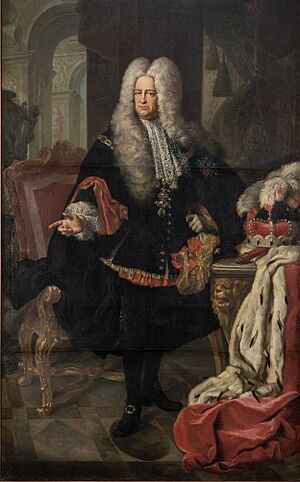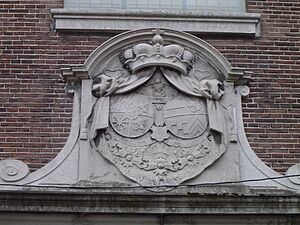Charles III Philip, Elector Palatine facts for kids
Quick facts for kids Charles III Philip |
|
|---|---|
 |
|
| Elector Palatine Count Palatine of Neuburg |
|
| Reign | 8 June 1716 – 31 December 1742 |
| Predecessor | John William |
| Successor | Charles Theodore |
| Born | 4 November 1661 Neuburg an der Donau |
| Died | 31 December 1742 (aged 81) Mannheim |
| Spouse |
Ludwika Karolina Radziwiłł
(m. 1688; died 1695)Teresa Lubomirska
(m. 1701; died 1712)Violente Theresia of Thurn and Taxis
(m. 1728) |
| Issue | Leopoldine Eleonore of Neuburg Maria Anna of Neuburg Countess Palatine Elisabeth Auguste Sofie of Neuburg Theophila Elisabeth Franziska Felicitas of Neuburg Anna Elisabeth Theophila of Neuburg |
| House | House of Wittelsbach |
| Father | Philip William, Elector Palatine |
| Mother | Elisabeth Amalie of Hesse-Darmstadt |
Charles III Philip (born November 4, 1661, died December 31, 1742) was an important ruler in Germany. He was the Elector Palatine, a powerful title, and also ruled over areas like Palatinate-Neuburg, Jülich, and Berg. He held these titles from 1716 until his death in 1742.
Early Life and Military Career
Charles Philip was born in Neuburg an der Donau. He was one of seventeen children! His parents were Philip William, Elector Palatine and Elisabeth Amalie of Hesse-Darmstadt.
When he was fourteen, Charles Philip became a cleric. This happened in Cologne, Salzburg, and Mainz. However, he never became a priest. Instead, he decided to join the military in 1684. He fought in the Habsburg wars against the Turks between 1691 and 1694. He was very successful and became an imperial field marshal, a high-ranking military leader. In 1712, he was made Governor of Further Austria in Innsbruck.
Becoming a Ruler
Charles Philip became the Elector Palatine after his brother, Johann Wilhelm, Elector Palatine, passed away in 1716. One of his first big decisions was to move the capital city. In 1720, he moved it from Heidelberg to a brand new city called Mannheim. Before leaving Heidelberg, he even promoted his favorite court jester, Perkeo of Heidelberg, to be in charge of the castle's wine!
Charles Philip wanted to make the Wittelsbach family stronger. This was his family's dynasty. To do this, he arranged a special wedding on January 17, 1742. His granddaughter, Elizabeth Auguste, married Charles Theodore of Palatinate-Sulzbach. Her sister, Maria Anna, married the Bavarian prince Clement. A few days later, Charles III Philip voted for his Bavarian cousin, Prince-Elector Charles Albert, in an important election.
Who Came Next?
When Charles III Philip died in December 1742, his direct family line ended. The Electorate of the Palatinate, which included Neuburg, Jülich, and Berg, was then passed to Charles Theodore. He was from a different branch of the Wittelsbach family, the Palatinate-Sulzbach line.
Another one of Charles Philip's granddaughters, Countess Palatine Maria Franziska of Sulzbach, later married Count Palatine Frederick Michael of Zweibrücken. Their son, Maximilian I Joseph, eventually became the heir to the Palatinate-Sulzbach line.
While in Mannheim, Charles III Philip helped create one of the best orchestras in Europe. Later, his successor, Charles IV Theodore, continued this tradition. Famous musicians like Johann Stamitz and Carlo Grua led this amazing orchestra. Even Leopold and Wolfgang Amadeus Mozart praised its talent!
Family Life
Charles Philip was married three times during his life.
His first marriage was in Berlin on August 10, 1688. He married Princess Ludwika Karolina Radziwiłł. She was a very wealthy heiress from Lithuania. They had four children together, but only one daughter, Elisabeth Auguste, lived to be an adult:
- Leopoldine Eleonore Josephine (1689–1693), who died young.
- Maria Anna (1690–1692), who died young.
- Elisabeth Auguste Sophie (1693–1728). She married her relative, Joseph Karl of Sulzbach, in 1717.
- A son who was stillborn in 1695.
After Ludwika passed away, Charles Philip married Princess Teresa Lubomirska. This marriage happened in Kraków on December 15, 1701. They had two daughters, but sadly, neither lived past the age of three:
- Theophila Elisabeth Franziska Felicitas (1703–1705).
- Anna Elisabeth Theophila (1709–1712).
In 1728, he married Countess Violente Maria Theresia of Thurn und Taxis. She was the daughter of Count Philipp-Wilhelm of Thurn and Taxis. This marriage did not produce any children. Violente was given the special title of Princess by Holy Roman Emperor Charles VI in 1733.
Charles III Philip died in Mannheim on December 31, 1742.



